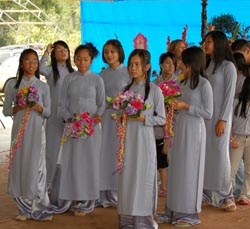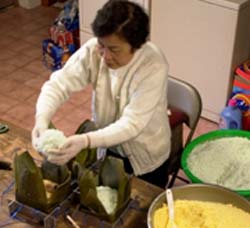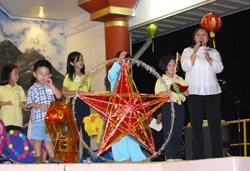Vietnamese Folklife in New Orleans
By Kathy Kilbourne
Approximately 12,000 Vietnamese live in New Orleans today, primarily in three concentrated communities in New Orleans East, Algiers, and Avondale. The majority of Vietnamese in Louisiana are Catholics who originally lived in North Vietnam. When Vietnam was divided in 1954 and the North came under Communist rule, they moved to South Vietnam and settled in three coastal communities above Saigon. Many were fishermen and farmers in Vietnam and continue to earn or supplement their living with these skills in Louisiana.

Because so many of the Vietnamese in the New Orleans area are from rural areas of Vietnam, they are familiar with many aspects of folklife from their childhoods. However, many do not see anything of particular note in their folklore and so do not take much care to preserve it here in a new land. Many Vietnamese feel that their language and culture will continue to survive because they are strong now.
Class and economic differences have an effect on which aspects of Vietnamese folklife are actively selected for preservation in Louisiana. Rural folklore is noted in passing by educated Vietnamese, but cultural conservationists in the community are generally more concerned with preserving Vietnamese literature, formal art, and cultural values.
Thus, traditional Vietnamese craftspeople can be hard to find in New Orleans. There are no self-employed folk artists in the area, for example. Some Vietnamese make and sell woodburnings or wooden pictures made with a jigsaw, but if traditional art is exhibited in Vietnamese homes it is usually elaborate lacquer paintings or pictures inlaid with mother-of-pearl. Such pictures are made in Vietnam and California and sold here.
Occupational traditions survive to various degrees among the many Vietnamese families who have connections with fishing in South Louisiana and the Gulf. In some of Louisiana's fishing communities, a handful of Vietnamese Americans who were boatbuilders in Vietnam continue to practice their craft, although the form of the boat has sometimes been adapted to the new environment. In New Orleans, Vietnamese craftsmen like Tanh Bui no longer build boats, because American fishermen want boats with fiberglass hulls. In fact, the majority of Vietnamese fishermen themselves now buy, rather than build, boats for themselves. However, most families who fish continue to make and mend their own nets.

Traditional dress is one aspect of Vietnamese folklife that has become largely ceremonial in Louisiana. The traditional dress for women is the ao dai, a tight bodice with a long, split tail that reaches below the knees over white pants. Although many women in Vietnam wear this regularly, here it is only worn for important occasions. Almost all women and girls own at least one, made by oneself or by a tailor. Ao dais are usually plain, often made of expensive silk, and sometimes decorated with embroidery or painted pictures.
Folk music seems to be surviving well although it is not always distinguishable as folk music to the American ear. Many of the popular Vietnamese pop singers (whose tapes sell in the hundreds in Vietnamese stores) and even some rock and New Wave singers include both folk songs and art songs by such musicians as Pham Duy, along with their modern songs. Although they can describe the songs and dances traditionally performed by country people, most Vietnamese do not make careful distinctions between folk and modern music.
Vietnamese folk dances can be divided into line dances and circle dances. Line dances, with one line of men (or girls dressed as men) and one line of women, are most typical of planting and harvest celebrations. The dance is a musical interpretation of the young men and women teasing each other as the farm community works together.
Circle dances are performed by women or girls who form various patterns as they move gracefully around the stage, often holding fans, decorated "coolie" hats, or candles. None of these dances have prescribed steps; instead the choreographer forms the music and designs of the new dance from combinations of steps and patterns. To date, no one has been identified in New Orleans who has studied or knows the formal court dancing which was performed in the palace in Hue.

Vietnamese cooking will probably survive longer and with fewer changes than any other cultural artifacts that Vietnamese have brought to this area, because the Vietnamese—young and old—prefer it to any other style of cooking and prepare all their meals using Vietnamese recipes. Many small Vietnamese grocery stores in the Vietnamese neighborhoods supply culinary needs and an open air market for gardeners' produce does brisk business every Saturday in New Orleans East.
Vietnamese communities in the New Orleans area often have extensive gardens behind the houses. These urban gardens are an important link with Vietnam and traditional life, especially for older people who may speak no English. The choice of plants (some of which are brought from Vietnam), the layout of the gardens, and gardening techniques all reflect culturally meaningful ways of doing things, although these too are changing in America.
Tet Trung Thu, the Mid-Autumn Festival, was originally a harvest festival associated with the moon and is now celebrated for the children's entertainment. Traditionally, children make elaborate lanterns from bamboo and tissue paper which are lit from within by candles or flashlight bulbs. Under the full moon groups of children parade, carrying their lanterns and singing the traditional Tet Trung Thu songs. Often communities organize a fair for Tet Trung Thu which includes prizes for the best lanterns .
The Vietnamese are so new to Louisiana that it will be a several years before we know which traditions are retained and which are discarded in their new home. Either way, they are a welcome addition to Louisiana's cultural mix.


